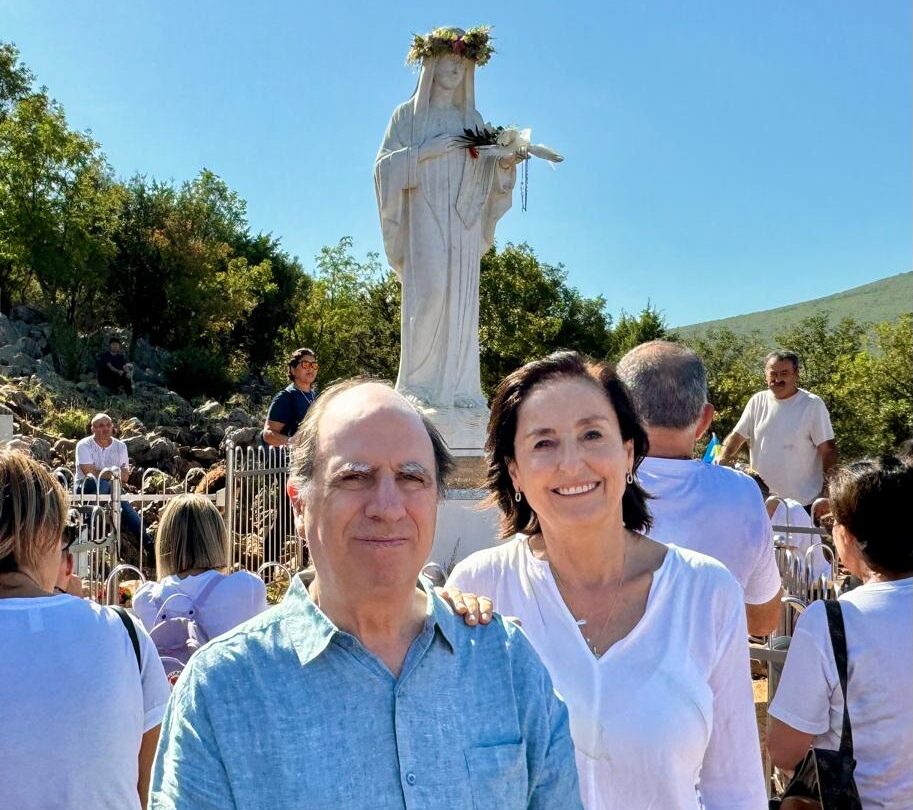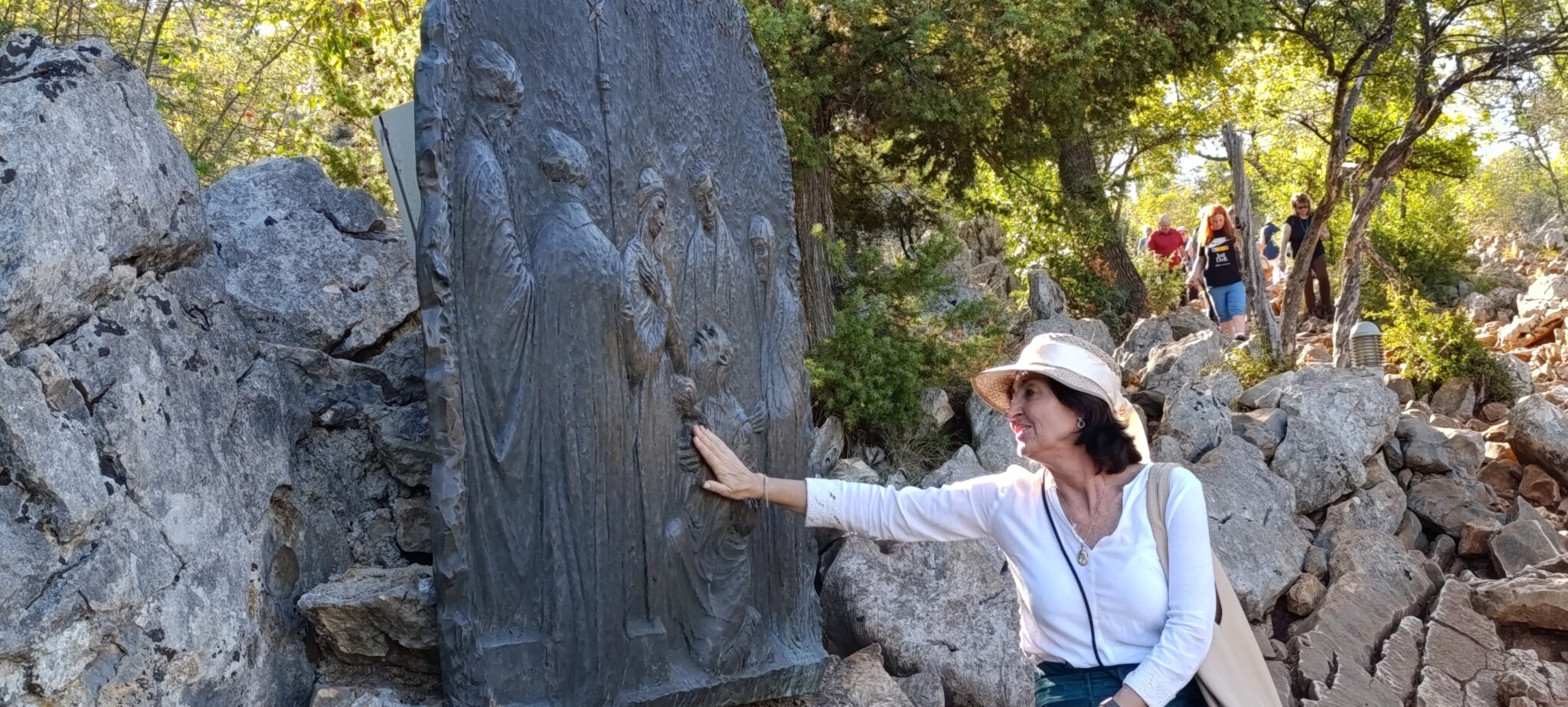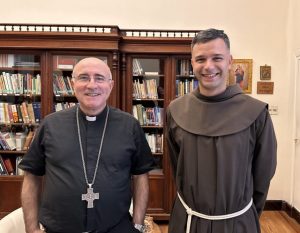
On September 6, Adriana Bezanilla, a Chilean singer-songwriter and member of the well-known Catholic group Betsaida, founded in 1990, arrived in Medjugorje on her first pilgrimage alongside her husband Rafael.
Adriana is 62 years old and was born in Chile as “the seventh” in a large family, as she told us. Together with Rafael, they have a large family, with five children on earth and three already in heaven, as well as seventeen grandchildren. Adriana described herself as “grateful and in love with Our Blessed Mother,” who has inspired her vocation, sought her out, loved her, and helped her carry everything forward. “What we have done with the Betsaida group, composing religious music, we have done in Her name, in the name of Our Blessed Mother.”
In Medjugorje, Rafael and Adriana spent a day and visited Apparition Hill, where they prayed the rosary and prayed silently before the statue of Our Blessed Mother. They also toured the parish with a local guide and participated in the evening prayer program.
Adriana spoke to us about her apostolate with the Betsaida group, her family, her life, and how the beautiful and popular Catholic song “María mírame” (Mary, Look at Me) came to be.
Adriana, how did your pilgrimage to Medjugorje come about? Who invited you?
A cousin of my husband, named Margarita, comes here every year. She is in love with Medjugorje. She would say to me, “I can’t believe you haven’t been. It’s something happening now, not a hundred years ago. It’s a capital of grace, a chimney of prayers, and Our Blessed Mother is there.”
Now, it took a bit to convince my husband Rafael (she smiles), but we made it, and I am extremely happy to have come, with every intention of returning to this living miracle.
How did the Betsaida group begin? What are you doing currently?
It’s a group of laypeople that formed after Pope John Paul II’s visit to Chile. We decided to come together and begin this ministry using the media—radio, television, videos, and music. We have recorded a lot, and now also software and many books, much audiovisual material. All this material is available on Betsaida’s website. Everything is there: sheet music, for instruments, for voices, everything… There are 13 albums and a musical called “Butterflies.” It’s like a Catholic version of “The Lion King,” with values.
Everything is available on all platforms—Deezer, YouTube, Spotify—it’s all free and can be used for your parishes or communities.
How did you start composing religious songs as an apostolate?
It all started because I worked in politics; I’m a political journalist. And when the Pope came and said, “The poor cannot wait,” something struck me, and I said, “I have to do something.” I left one morning a week to work with small businesswomen in the outskirts of Santiago, in poor neighborhoods. I realized that I prepared all sorts of material for them, but what touched them most was the song I would sing to them. In the end, I started composing songs to carry out the apostolate and to teach them. For example, how did I teach them the mystery of Transubstantiation—that the Lord is present in body, blood, soul, and divinity? The song says: “Every time I receive you, Lord, something great happens in me…” And so, we used it as a means of evangelization until a priest said to us, “Why don’t you record this?” And that’s how Betsaida 1, 2, 3, 4, 5… came about.
What is the latest thing Betsaida has done?
The last thing we did was the musical I mentioned earlier, which is also available as a nine-episode podcast, like a radio play. We toured all over Chile with it; it was beautiful.
And “María mírame”… did it also come from these catechisms you were doing in the neighborhoods?
Exactly, from those catechisms in the neighborhoods of Santiago. We have two saints in Chile: Father Saint Alberto Hurtado and Saint Teresa of the Andes. “María mírame” has many elements taken from a prayer by Father Alberto Hurtado, who would say: “María mírame, que si tú me miras, Él me mirará” (Mary, look at me, for if you look at me, He will look at me). The song is inspired by a prayer of Father Saint Alberto Hurtado.
How was your experience in Medjugorje?
It exceeded all my expectations. What I felt was very powerful, especially last night during the Mass, the confessions, the veneration of the cross. The silence, the devotion of the people, something very supernatural was happening. Truly, I hadn’t experienced anything like it anywhere else. I believe there is a very strong force here that will change many things, that will do a lot.
What spiritual fruit do you take from Medjugorje that might be different after this experience?
Oh, I want to do everything! (she smiles). That’s part of my personality; I want to do it all. Our Blessed Mother and my spiritual director will guide me on how much and how to do it, but… right now, I want everything. A total commitment. I want my children and grandchildren to fall in love with Our Blessed Mother and Jesus Christ and to live to get to Heaven, the only inheritance that matters to me.
Adriana said her goodbyes with heartfelt gratitude to God and also to the Gospa for everything she experienced on her first pilgrimage to this holy place: “Thank you, thank you, thank you! For everything, for all the testimonies, for the fervor, for the faith, for the help… thanks to the Lord that I had the opportunity and the grace to come here to Medjugorje!”
It’s fitting to end this news piece with what is said on Betsaida’s website, along with the video of “María mírame,” so that we can all sing and ask the Queen of Peace to look at us, and thus, Jesus will also look at us, as Saint Alberto Hurtado prayed.
“Philip was from Bethsaida, the town of Andrew and Peter.” (John 1:44)
Bethsaida is a place north of the Sea of Galilee, where Jesus spent much of his public life. There, he won over several of his apostles, preached, and performed many miracles. Two thousand years later, a group of Chilean laypeople gathered under the same name, with the intention of composing and singing religious music as their chosen apostolate.
Following the call of the Holy Father for laypeople to make use of technological advancements for evangelization, they embarked on various projects: albums, music videos, radio programs, podcasts, and children’s material.




